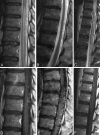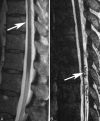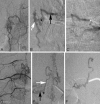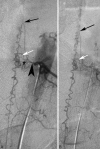Spinal dural arteriovenous fistulas
- PMID: 19213818
- PMCID: PMC7051782
- DOI: 10.3174/ajnr.A1485
Spinal dural arteriovenous fistulas
Abstract
Spinal dural arteriovenous (AV) fistulas are the most commonly encountered vascular malformation of the spinal cord and a treatable cause for progressive para- or tetraplegia. They most commonly affect elderly men and are classically found in the thoracolumbar region. The AV shunt is located inside the dura mater close to the spinal nerve root where the arterial blood from a radiculomeningeal artery enters a radicular vein. The increase in spinal venous pressure leads to decreased drainage of normal spinal veins, venous congestion, and the clinical findings of progressive myelopathy. On MR imaging, the combination of cord edema, perimedullary dilated vessels, and cord enhancement is characteristic. Therapy has to be aimed at occluding the shunting zone, either by superselective embolization with a liquid embolic agent or by a neurosurgical approach. Following occlusion of the fistula, the progression of the disease can be stopped and improvement of symptoms is typically observed.
Figures









References
-
- Eichmann A, Yuan L, Moyon D, et al Vascular development: from precursor cells to branched arterial and venous networks. Int J Dev Biol 2005;49:259–67 - PubMed
-
- O'Rahilly R, Muller F. Neurulation in the normal human embryo. Ciba Found Symp 1994;181:70–82, discussion 82–89 - PubMed
-
- Groen RJ, Grobbelaar M, Muller CJ, et al. Morphology of the human internal vertebral venous plexus: a cadaver study after latex injection in the 21–25-week fetus. Clin Anat 2005;18:397–403 - PubMed
-
- Geibprasert S, Pereira V, Krings T, et al. Dural arteriovenous shunts: a new classification of craniospinal epidural venous anatomical bases and clinical correlations. Stroke 2008;39:2783–94 - PubMed
Publication types
MeSH terms
LinkOut - more resources
Full Text Sources
Medical
